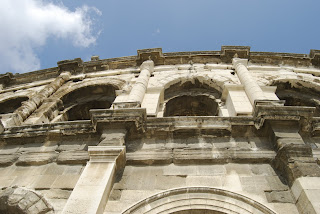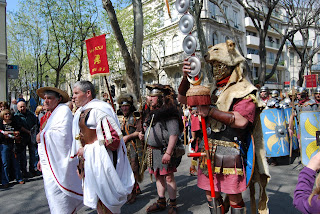




























Another beautiful day here in Provence, with a near cloudless blue sky and a sun that warms and browns without burning. Avignon has provided us with far and away the best weather that we've had on our trip. While I expressed some weather doubts about the timing of our trip in my last post, I'm thinking now that the advice would only pertain to the Cote d'Azur, where you really need some nice weather to get the water warmed up. Here in the interior 20 C will do just fine, thank you very much.
We'll be expecting the thanks of all the European travelers stranded by the Icelandic ash cloud. We went ahead today and booked some train tickets to ensure we could get home on Thursday as planned. The Eurostar through the Chunnel, which is refundable if our plane gets to fly from Paris, and a direct London to Aberdeen 7 hour marathon, which is non-refundable. We thought it better to go ahead and buy the tickets than to get to Thursday and have no viable alternatives. I am certain, though, that now that we have laid out more money, the ash will shift and the airspace will open back up. Oh well, now at least we can have a worry free Paris leg of our trip instead of fretting over how we were going to get home.
Our destination today has changed a little bit over the last day or so. We always thought we would go in the direction of Nimes or Arles, to take in some more Roman arenas and theatres. But we found some literature talking about tours of Vincent Van Gogh related areas in and around Arles. You could see where he painted Starry Night and the Cafe. But Fiona also found a once in a lifetime happening in Nimes that we had to take advantage of - a real set of Roman Games in the arena. So we pushed the Van Gogh tour into the itinerary for our next trip (next to a couple of days in the ornithological park on the coast and a winery tour) and headed for Nimes.
Nimes was first settled by Roman soldiers, veterans from Julius Caesar's campaigns along the Nile. The town crest, a crocodile chained to a palm tree, makes sure this heritage is abundantly clear to everyone, as it is plastered on everything. Once a year the citizens get all Roman-ized with togas and tunics and parade down the main street of town, from the old temple to the 2000 year old intact arena. The parade was really cool, with senators, legionnaires, gladiators, chariots all escorting the emperor down the street.
This year, however, they decided to do a little extra and put on a full set of games as well. The legions all trooped into the arena, flying their colors as the musicians trumpeted the arrival of the emperor. He joined the senators and local dignitaries in the royal box and kicked off the games. They started with a demonstration of equestrian prowess, barbarians versus Romans. Dummies were filled with spears and cabbages were chopped at a full gallop. While the Romans were clearly better at all disciplines, the barbarians had more flair and the crowd determined that they had won the competition.
Next came the gladiators, a combination of all sorts, making a loop of the stadium with their people carrying their nameplates following behind. They squared off one on one and proceeded to teach us all a little something about gladiatorial combat that we didn't get from the movie. Apparently there were two referees that looked after each match, separating the combatants when things got too lively. After one of the gladiators had accumulated enough "points", the crowd would then decide whether the loser could/should be killed by the winner. If you wanted him to live, you waved your white hanky (kindly supplied by the organizers). If you wanted death, you booed loudly. Based on the crowd's response the emperor would make the final decision. Our favorite, the net fighter, was one of the losers that was spared by the crowd. Only two deaths were requested by the crowd, people took a very harsh line on those gladiators that weren't perceived to have played fair.
The grand finale was gladiatorial combat from chariots, with two teams of horses pulling their charioteers and spearmen around the arena. As they careened about you could tell that this was the most dangerous part of the show, and indeed there was one head on collision, but in the end they could safely include the standard item in the credits - no humans or animals were harmed during the making of this show.
It was all a little camp, but we really got into it and thoroughly enjoyed ourselves. Even with the slightly less than believable combat, the venue added a lot of legitimacy. Under the same circumstances, 2000 years ago, with 24,000 screaming inhabitants baying for blood, it would truly have been a sight to behold. I wonder if they would have been as merciful as we were ... ?

























